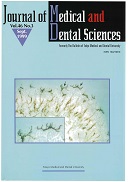All issues

Volume 46 (1999)
- Issue 4 Pages 139-
- Issue 3 Pages 105-
- Issue 2 Pages 63-
- Issue 1 Pages 1-
Volume 46, Issue 3
Displaying 1-5 of 5 articles from this issue
- |<
- <
- 1
- >
- >|
-
Hiroshi Uematsu1999Volume 46Issue 3 Pages 105-110
Published: 1999
Released on J-STAGE: May 01, 2017
JOURNAL OPEN ACCESSDownload PDF (614K) -
Ali Al Marzooq, Masaru Yatabe, Minoru Ai1999Volume 46Issue 3 Pages 111-116
Published: 1999
Released on J-STAGE: May 01, 2017
JOURNAL OPEN ACCESSRecent studies and literature reviews of temporomandibular disorders (TMD) do not strongly support the role of occlusal etiologic factors. For this paper we collected and classified studies dealing with occlusion as a contributing factor to TMD through reviews, and discussions of these difficulties and possible solutions. Related articles from 275 papers covering nearly the past twenty years were selected from a prosthetic point of view and reviewed. The validity and reliability of occlusal examinations, however, are questionable since the epidemiological studies dealt with numerous varied subjects. Although occlusal relationships, such as overbite, non-working side interferences, and discrepancy between the intercuspal position and the retruded contact position, have often been considered as contributing factors of TMD, there is no consistency among even those studies that support such an occlusal factor. A project should be initiated to create a revised, precise and practical method to determine the occlusal contact and to categorize an occlusal contact scheme. To detect whether the patients' occlusal scheme works traumatically or not should be an important part of the occlusal examination. That is, the frequency and duration of tooth contact on the occlusal scheme should be studied.View full abstractDownload PDF (900K) -
Wagner Rodrigues Duarte, Yuko Mikuni-Takagaki, Toshio Kawase, Tadahir ...1999Volume 46Issue 3 Pages 117-122
Published: 1999
Released on J-STAGE: May 01, 2017
JOURNAL OPEN ACCESSThe periodontal ligament (PDL) functions under constant mechanical stress, and PDL cells obviously control PDL functions under such conditions. We have previously found that the mRNA expression of the Ca2+·-binding protein S100A4 and β-actin is higher in the PDL from erupted teeth than in the PDL from teeth under eruption. This suggested a role for S100A4 in the response of PDL cells to mechanical stress, possibly by coupling Ca2+ and the cytoskeletal system. In the present study, we investigated the direct effects of cyclical stretching on the mRNA expression of S100A4 and two cytoskeletal components (β-actin and α-tubulin) by PDL cells. In Northern blotting analysis, the expression of S100A4, β-actin, and α-tubulin mRNAs was higher in the PDL from fully erupted and functional bovine teeth than in partially erupted ones. Similarly, when bovine PDL cells were mechanically stimulated by means of the Flexercell Strain Unit, the expression of S100A4,β-actin, and α-tubulin mRNAs increased over the control levels. The results of our present study indicate that S100A4 is involved in the responses of PDL cells to mechanical stress possibly by coupling Ca2+ to the cytoskeletal system in these cells.View full abstractDownload PDF (996K) -
Mitsuro Tanaka, Kosuke Matsunaga, Yoshinori Kadoma1999Volume 46Issue 3 Pages 123-126
Published: 1999
Released on J-STAGE: May 01, 2017
JOURNAL OPEN ACCESSPrevious research has shown that rinsing the mouth with milk significantly diminished the pH in dental plaque fluid; however, the degree of saturation with respect to the dental enamel (DS) was not significantly decreased because of an increase in the calcium ion concentration in plaque fluid. The aim of this study was to investigate the cariostatic effect of adding calcium to milk on the DS value of the plaque fluid after rinsing. Plaque samples were collected from 8 Japanese male dental students. Prior to plaque collection, all subjects refrained from practicing oral hygiene for 48 hr and fasted overnight. Supragingival plaque samples were collected from one side of the mouth of each subject, and then collected from the other side, following a 30-second rinse with 15 mL of calcium-enriched milk, which was prepared by adding calcium carbonate to ordinary milk, and a 10-minute waiting period. The samples were cleared by centrifugation, and the plaque fluid was analyzed for inorganic ions and pH, using an ion chromatograph and pH microelectrode, respectively. The calcium ion concentration of the milk was 6.4 mM, which was about 36% higher than that of ordinary milk. The pH decreased significantly (p<5%) from 6.4 to 6.1 following the rinse with calcium enriched milk, as tested by the paired t-test. The decrease in pH might have caused a reduction of the DS value; however, it was compensated for by a significant (p<0.5%) increase in the calcium ion concentration of plaque fluid.View full abstractDownload PDF (571K) -
Tomoaki Kikyo, Miki Saito, Masaaki Ishikawa1999Volume 46Issue 3 Pages 127-137
Published: 1999
Released on J-STAGE: May 01, 2017
JOURNAL OPEN ACCESSThe tongue surface movement of young patients with or without open bite was evaluated by ultrasound images taken on the posterior part of the tongue on the frontal plane to determine whether there is any relationship between the tongue movement and open bite malocclusion in the early mixed dentition period. The standardized reproducible ultrasound images were obtained using ultrasound diagnostic equipment that was fabricated in a cephalostat unit having a probe stabilizer. At the central portion of the tongue, no significant differences were detected in the duration or the momentum of tongue surface movement on a frontal plane was detected between the patients with and without open bite during swallowing. The farther the region was from the central portion, however, the longer the duration and the bigger the momentum of the tongue surface movement was found in the open bite group. Based on this evidence, it is suggested that an open-bite child swallows by using a tongue thrust motion that forms using a large depressed area in the tongue, whereas a normal child without tongue thrust forms a rather narrow groove in the central portion of the tongue when swallowing.View full abstractDownload PDF (3528K)
- |<
- <
- 1
- >
- >|